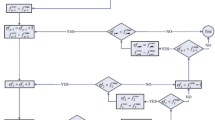Abstract
Recently, the traffic network exhibits a very critical situation due to the speedy rise of urbanization and population growth. This paper suggests a better solution for such traffic issues via delay-optimized Shortest Path Prediction (SPP) method. Even though Shadowed Type 2 (ST2) fuzzy logic works well for delay optimization with uncertain data, it causes a rise in fuzzy partitioning complexity. This motivates to development Shadowed Type 2 Fuzzy Markov (ST2FM) scheme for accurate prediction of the shortest path. In ST2FM, waiting for time optimization performed at rush junction based on ST2 fuzzy rules. Optimized path detail is periodically updated in the Transition Probability Matrix of the Markov model for SPP. Thus, ST2FM helps a node to easily identify the shortest path to reach the destination without waiting at traffic junctions. The absence of fuzzy partitioning and the use of Markov prediction greatly reduce the computational complexity of ST2FM. Matlab 2016a working environment is utilized for research implementation and results are compared with ST2 fuzzy, Interval Type 2 fuzzy and Fuzzy-based Convolution Neural Network. From this analysis, the proposed work demonstrates 96% of prediction accuracy with less error than existing works.









Similar content being viewed by others
References
Ajao LA, Ajao FJ, Adegboye MA, Ismail AA (2018) An embedded fuzzy logic based application for density traffic control system. Int J Artif Intell Res 2(1):6–13
An J, Fu L, Hu M, Chen W, Zhan J (2019) A novel fuzzy-based convolutional neural network method to traffic flow prediction with uncertain traffic accident information. IEEE Access 7:20708–20722
Chandel S, Yadav S, Yadav S (2018) Modern traffic control system. Malaya J Mat MJM S:22–25
Chatterjee K, De A, Chan FT (2019) Real time traffic delay optimization using shadowed type-2 fuzzy rule base. Appl Soft Comput 74:226–241
Chen W, An J, Li R, Fu L, Xie G, Bhuiyan MZA, Li K (2018) A novel fuzzy deep-learning approach to traffic flow prediction with uncertain spatial–temporal data features. Future Gener Comput Syst 89:78–88
Dong S, Wu ZG, Pan YJ, Su H, Liu Y (2018a) Hidden-Markov-model-based asynchronous filter design of nonlinear Markov jump systems in continuous-time domain. IEEE Trans Cybern 99:1–11
Dong S, Wu ZG, Shi P, Su H, Huang T (2018b) Quantized control of Markov jump nonlinear systems based on fuzzy hidden Markov model. IEEE Trans Cybern 99:1–11
Ghosh S, Das A (2019) Urban growth modeling of a rapidly urbanizing area using FMCCA model. Arab J Geosci 12(6):218
Goyal M, Priya A, Kumar C, Verma V, Hota MK (2018) An ingenious traffic control system using fuzzy logic control with emergency override feature. In: 2018 IEEE international conference on system, computation, automation and networking (ICSCA) IEEE, pp 1–6
Hakim GP, Firdausi A, Alaydrus M, Budiyanto S (2018) Dynamic traffic light timing control system using fuzzy TOPSIS algorithm. IOP Conf Ser Mater Sci Eng IOP Publ 453(1):012063
Hartanti D, Aziza RN, Siswipraptini PC (2019) Optimization of smart traffic lights to prevent traffic congestion using fuzzy logic. TELKOMNIKA 17(1):320–327
Ivaschuk O, Grecheneva A, Kuzichkin O, Aparin I, Dorofeev N (2018) Application of the accelerometric control method of transport stream in the system of geotechnical monitoring. Int Multidiscip Sci GeoConf SGEM Surv Geol Min Ecol Manag 18:91–98
Lana I, Del Ser J, Velez M, Vlahogianni EI (2018) Road traffic forecasting: recent advances and new challenges. IEEE Intell Transp Syst Mag 10(2):93–109
Liang X, Du X, Wang G, Han Z (2018) Deep reinforcement learning for traffic light control in vehicular networks. arXiv preprint arXiv:1803.11115
Mir A, Hassan A (2018) Fuzzy inference rule based neural traffic light controller. In: 2018 IEEE international conference on mechatronics and automation (ICMA) IEEE, pp 816–820
Nagarajan D, Lathamaheswari M, Broumi S, Kavikumar J (2019) A new perspective on traffic control management perspectives, using triangular interval type-2 fuzzy sets and interval neutrosophic sets. Oper Res 6:100099
Ruiz-Garcia G, Hagras H, Pomares H, Rojas I (2019) Towards a fuzzy logic system based on general forms of interval type-2 fuzzy sets. IEEE Trans Fuzzy Syst 27:2381–2395
Shen H, Li F, Wu ZG, Park JH, Sreeram V (2018a) Fuzzy-model-based nonfragile control for nonlinear singularly perturbed systems with semi-Markov jump parameters. IEEE Trans Fuzzy Syst 26(6):3428–3439
Shen L, Liu R, Yao Z, Wu W, Yang H (2018b) Development of dynamic platoon dispersion models for predictive traffic signal control. IEEE Trans Intell Transp Syst 99:1–10
Vogel A, Oremović I, Šimić R, Ivanjko E (2018) Improving traffic light control by means of fuzzy logic. In: 2018 international symposium ELMAR IEEE, pp 51–56
Yu C, Feng Y, Liu HX, Ma W, Yang X (2018) Integrated optimization of traffic signals and vehicle trajectories at isolated urban intersections. Transp Res Part B Methodol 112:89–112
Funding
No funding is provided for the preparation of manuscript.
Author information
Authors and Affiliations
Corresponding author
Ethics declarations
Conflict of interest
Authors Pawan Kumar and Chanchal Dudeja declare that they have no conflict of interest.
Ethical approval
This article does not contain any studies with human participants or animals performed by any of the authors.
Additional information
Communicated by V. Loia.
Publisher's Note
Springer Nature remains neutral with regard to jurisdictional claims in published maps and institutional affiliations.
Rights and permissions
About this article
Cite this article
Kumar, P., Dudeja, C. Shadowed type 2 fuzzy-based Markov model to predict shortest path with optimized waiting time. Soft Comput 25, 995–1005 (2021). https://doi.org/10.1007/s00500-020-05194-y
Published:
Issue Date:
DOI: https://doi.org/10.1007/s00500-020-05194-y




